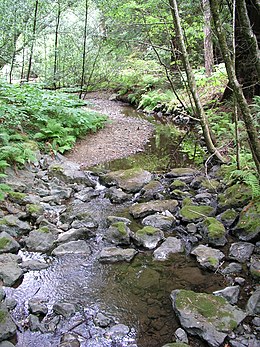
Back نظام بيئي نهري Arabic Ecosistema lótico Spanish Jõeelustik Estonian بومسازگان رودخانه Persian Écologie des systèmes lotiques French Речные экосистемы Russian Rečni ekosistem Slovenian Екосистем копнених текућих вода Serbian ஆற்றுச் சூழல்மண்டலம் Tamil Hệ sinh thái sông Vietnamese

River ecosystems are flowing waters that drain the landscape, and include the biotic (living) interactions amongst plants, animals and micro-organisms, as well as abiotic (nonliving) physical and chemical interactions of its many parts.[1][2] River ecosystems are part of larger watershed networks or catchments, where smaller headwater streams drain into mid-size streams, which progressively drain into larger river networks. The major zones in river ecosystems are determined by the river bed's gradient or by the velocity of the current. Faster moving turbulent water typically contains greater concentrations of dissolved oxygen, which supports greater biodiversity than the slow-moving water of pools. These distinctions form the basis for the division of rivers into upland and lowland rivers.
The food base of streams within riparian forests is mostly derived from the trees, but wider streams and those that lack a canopy derive the majority of their food base from algae. Anadromous fish are also an important source of nutrients. Environmental threats to rivers include loss of water, dams, chemical pollution and introduced species.[3] A dam produces negative effects that continue down the watershed. The most important negative effects are the reduction of spring flooding, which damages wetlands, and the retention of sediment, which leads to the loss of deltaic wetlands.[4]
River ecosystems are prime examples of lotic ecosystems. Lotic refers to flowing water, from the Latin lotus, meaning washed. Lotic waters range from springs only a few centimeters wide to major rivers kilometers in width.[5] Much of this article applies to lotic ecosystems in general, including related lotic systems such as streams and springs. Lotic ecosystems can be contrasted with lentic ecosystems, which involve relatively still terrestrial waters such as lakes, ponds, and wetlands. Together, these two ecosystems form the more general study area of freshwater or aquatic ecology.
The following unifying characteristics make the ecology of running waters unique among aquatic habitats: the flow is unidirectional, there is a state of continuous physical change, and there is a high degree of spatial and temporal heterogeneity at all scales (microhabitats), the variability between lotic systems is quite high and the biota is specialized to live with flow conditions.[6]
- ^ Angelier, E. 2003. Ecology of Streams and Rivers. Science Publishers, Inc., Enfield. Pp. 215.
- ^ "Biology Concepts & Connections Sixth Edition", Campbell, Neil A. (2009), page 2, 3 and G-9. Retrieved 2010-06-14.
- ^ Alexander, David E. (1 May 1999). Encyclopedia of Environmental Science. Springer. ISBN 0-412-74050-8.
- ^ Keddy, Paul A. (2010). Wetland Ecology. Principles and Conservation. Cambridge University Press. p. 497. ISBN 978-0-521-51940-3.
- ^ Allan, J.D. 1995. Stream Ecology: structure and function of running waters. Chapman and Hall, London. Pp. 388.
- ^ Giller, S. and B. Malmqvist. 1998. The Biology of Streams and Rivers. Oxford University Press, Oxford. Pp. 296.
© MMXXIII Rich X Search. We shall prevail. All rights reserved. Rich X Search